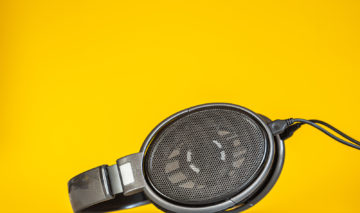How to Navigate Audio File Recovery on Digital Voice Recorders
Use this step-by-step instruction here to learn how to navigate audio file recovery on digital voice recorders.

We have all been on a train, a plane or in a waiting room, where someone is wearing headphones that seem to leak an unusual amount of sound.
We may think that this person is crazy for listening to their music that loud, but there is a strong chance that they are wearing open back headphones (see also can wearing headphones cause hair loss).
Open back headphones leak more sound than closed back headphones and may distract those around you.
If you’re on the market for a new pair of headphones (don’t forget to burn in your new headphones) and are considering open backs, or you own them already, you should have a sense of how much sound is leaking out of your headphones.
All headphones leak some amount of sound. Some headphones leak more sound than others, which is an important factor to consider when purchasing a pair of headphones. Open back headphones are estimated to leak about 30-35% of sound.
Take into account where and when you’ll be using your open back headphones, as they may be disturbing to those around you.
Before diving into sound leakage, it’s important to understand what open back headphones actually are.
Open back headphones are simply headphones that have perforated, vented or mesh-covered ear cup enclosures that present a kind of see-through quality.
Due to their open nature, when you check the enclosures of open-back headphones, you can usually see the headphone driver.
Open back headphones have a clear presentation of audio details. Due to the open earcup enclosure design, sound waves are free to flow without being obstructed, as is the case with closed back headphones.
This free-flowing design allows you to hear richer details, gives a wider soundstage, with immersive reproduction.
Open back headphones can make audio like vocals and musical instruments sound like they are coming from different directions, as if you are immersed in the audio itself.
Open back headphones have an airy quality that allows for a vivid and clear listening experience. But in order to provide that listening experience, there are some inevitable downsides.
Because air can flow in and out of the open earcup enclosure, there is going to be a lot of ambient, or unwanted outside noise that leaks into your ears. In other words, while these headphones can cover your entire ear, you are still going to hear noise from your surroundings.
As I mentioned earlier, there is going to be noticeable sound leakage from the audio that you are listening to that others who are around you will most likely hear.
Durability is also a concern. Due to the nature of the design, these headphones are typically fragile and do not hold up well with rough or careless usage.
Open back headphones produce some of the most authentic and detailed audio on the market. This design can give an audiophile who values a wide range of audio detail a great tool for appreciating complex and variable audio.
Due to the precision with which sound can be understood and enjoyed, open back headphones are a great tool for audio engineers and producers who need to have access to a wide range of frequencies and experience them as they were initially recorded.
That being said, if you are looking for some everyday headphones for casual listening, these headphones may not be the best match for you.
Sound leakage is audio that is being moved in and out through the headphones, which surrounding listeners are able to hear. On the flipside, outside noise can leak into your ears as well, which may cause some disruption to your listening experience.
While all open back headphones are going to have sound leakage, the best way to test for exactly how much is to stand near someone who is wearing open backs, and listen to the leakage.
Try bringing a friend shopping with you and have them try on a pair of open backs. If you would feel uncomfortable having that much audio leaked to others, or if you find that the leakage is just too annoying, then maybe open backs aren’t right for you.
On the other hand, if you try them on yourself and are not bothered by the ambient noise that leaks in and you feel that these would be great for your own audio work or private listening, you will not be disappointed with open back headphones.
The headphones market is rather large, and it can be tricky to find the right pair of headphones for you without a little help. This is especially true of open back headphones, where different brands have clear advantages and disadvantages.
This buying guide, Best Open Back Headphones of 2021, is a great resource for anyone looking to explore the world of open back headphones. This guide will break down the pros and cons of some of the best open backs on the market, while also taking a deep dive into how open backs function and what they are made of.
Familiarizing yourself with what open backs do and what they are used for is the best way to decide if they are right for you.
Open back headphones have some of the best audio quality, if not the best, when it comes to on ear or over ear headphones.
The open earcup enclosure design allows free flowing sound waves to provide an immersive listening experience, making the listener feel like they are actually in the room hearing live audio.
However, the very nature of open back headphones means that they leak audio and allow outside audio to leak in. Make sure you are comfortable with your listening context and be aware that open backs are fragile devices that put audio quality first.